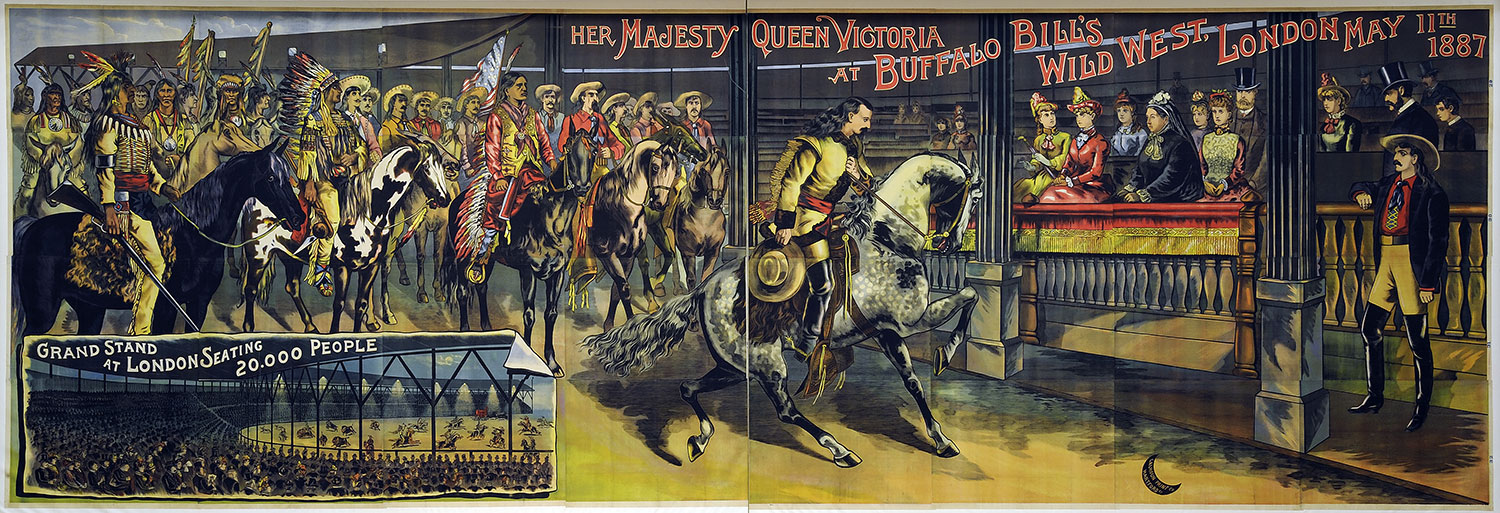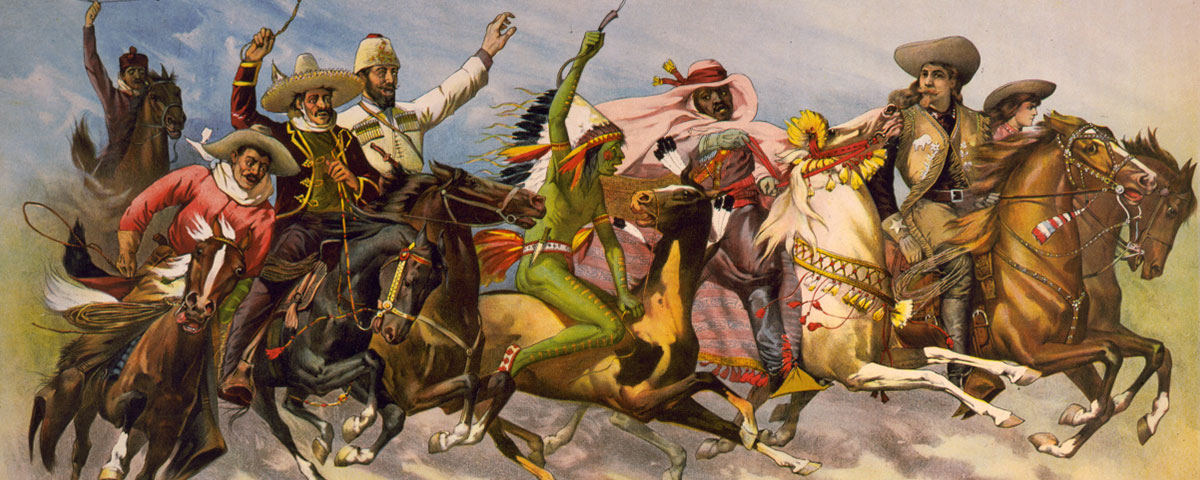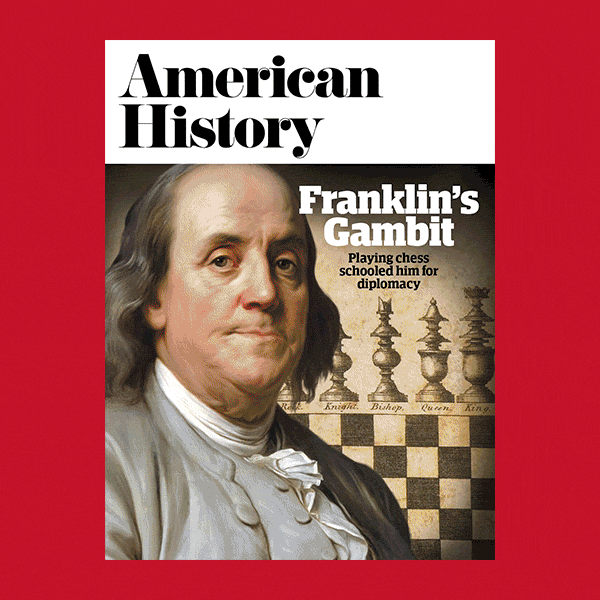IN THE SPRING of 1887, Buffalo Bill Cody sailed from New York to England with his entire “Wild West” show—cowboys, sharpshooters, musicians and 97 American Indians, plus 180 horses, 18 buffalo, 10 elk, 10 mules, 5 Texas steers and the old Deadwood stagecoach. For two days, a storm pummeled and rocked the steamship, causing Cody and nearly every other passenger—except Annie Oakley, the 26-year-old sharpshooter—to become violently seasick.
“The water looked like mountains,” Black Elk, an Oglala Sioux who performed in the show, recalled years later. Convinced they were doomed, the Sioux put on their best clothes and chanted songs of death. “If it was the end of our lives, and we could do nothing,” Black Elk explained, “we wanted to die brave.”
They didn’t die. The storm abated, the seas calmed and the Wild West show arrived safely in London for its European debut. A former trapper, army scout, actor and, of course, buffalo hunter, Cody had founded his Wild West extravaganza in 1883, and it played to huge crowds across America. Now 41, he brought the show to England during the Queen’s Jubilee—a summer of celebrations for Queen Victoria’s 50th year on the throne. The Wild West Show opened in London on May 9, 1887, before a crowd of 28,000 in a huge outdoor arena.
“Ladies and gentlemen,” ringmaster Frank Richmond bellowed, “the one and only, genuine and authentic, unique and original—Wild West!”
At that, nearly 200 performers—cowboys, Indians and Mexican vaqueros—galloped into the arena whooping and hooting, followed by Buffalo Bill riding Old Charlie, the horse he described as having “almost human intelligence, extraordinary speed, endurance and fidelity,” and silently waving his cowboy hat. Then the show began. Cowboys lassoed steers and rode bucking broncos. Indians attacked a wagon train until Cody and his cowboys rode to the rescue. Annie Oakley shot a cigar out of her husband’s mouth. A cowboy named Mustang Jack jumped over a full-grown horse and landed on his feet, then did it again holding two 10-pound dumbbells. Indians attacked the Deadwood stagecoach until Cody and his cowboys rode to the rescue again. The Indians chased buffalo, erected a village of tepees and performed a war dance. Galloping at full speed, Cody shot dozens of glass balls thrown into the air. Indians attacked a log cabin until Cody and his cowboys rode to the rescue once more.
The crowd cheered and the critics raved. “Buffalo Bill’s entertainment is assuredly the most remarkable ever seen in this country,” said the Illustrated London News, and Sporting Life agreed: “It is new, it is brilliant, it will ‘go’!”

Maybe the queen read those reviews or maybe she talked to her son Edward, the Prince of Wales, who loved the show. She wrote to Cody requesting a private performance “by royal command.” Cody was delighted to obey. It was a rare honor. Victoria, then 67, occasionally summoned actors to perform at Windsor Palace, but she seldom made public appearances after the death of her husband, Prince Albert, 26 years earlier, in 1861.
“She came to the show in a big shining wagon, and there were soldiers on both sides of her,” Black Elk remembered. “That day, other people could not come to the show—just Grandmother England and some people who came with her.”
It was an audience of 26—the queen and her entourage, sitting in the royal box in grandstands that could hold 40,000. A horseman rode into the arena carrying an American flag while the ringmaster announced that the flag stood for peace and friendship. The queen rose to her feet and bowed deeply.
“Then—we couldn’t help it—there arose such a genuine heart-stirring American yell from our company as seemed to shake the sky,” Cody later wrote. “It was a great event. For the first time in history, since the Declaration of Independence, a sovereign of Great Britain had saluted a star-spangled banner, and that banner was carried by a member of Buffalo Bill’s Wild West.”
Cody rode to the royal box on Old Charlie, bowed to the queen and said, “Welcome, Your Majesty, to the Wild West of America.”
Then the show began. “The whole company seemed infected with a determination to excel themselves,” Cody later recalled. “Personally, I missed not a single shot, and the young ladies [Annie Oakley and another sharpshooter, 16-year-old Lillian Smith] excelled themselves in the same line; the charges on the Indians were delivered with a terrific vim; and the very bucking horses seemed to buck like steam engines.”
“We danced and sang,” recalled Black Elk, “and I was one of the dancers chosen to do this for the Grandmother, because I was young and limber then and could dance many ways. We stood right in front of Grandmother England. She was little but fat and we liked her.”
After the show, the queen requested that the performers come over to meet her. She told Cody that she enjoyed the show. Cody recalled that she said other things, too, but he kept them to himself: “Modesty forbids me to repeat them.”
The queen had many questions for Annie Oakley. “I stepped near,” Oakley recalled, “and she asked me when I was born, at what age I took up shooting and several other questions and finished by saying, ‘You are a very, very clever little girl.’ To be called clever by Queen Victoria meant the highest compliment, and with a ‘I thank you, Your Majesty,’ I bowed myself out.”
Cody introduced Her Majesty to several Sioux performers. “She shook hands with all of us,” Black Elk remembered. “Her hand was very little and soft. We gave a big cheer for her and then the shining wagons came in and she got in one of them and they all went away.”
Back home at Windsor Castle that night, Victoria described the day in her journal: “Wild painted Red Indians from America, on their wild bare backed horses, of different tribes—cowboys, Mexicans &c., all came tearing around at full speed, shrieking and screaming, which had the weirdest effect. An attack on a coach & on a ranch, with an immense deal of firing, was most exciting, so was the buffalo hunt & the bucking ponies. . . .The cowboys are fine looking people, but the painted Indians, with their feathers and wild dress (very little of it) were rather alarming looking & they have cruel faces. . . .Col. Cody, ‘Buffalo Bill’ as he is called, from having killed 3000 buffaloes, with his own hand, is a splendid man, handsome and gentlemanlike in manner. He has had many encounters & hand to hand fights with the Red Indians. Their war dances, to a wild drum and pipe, was quite fearful, with all their contorsions [sic] and shrieks, & they come so close.”
Decades later, in 1931, Black Elk—who had witnessed both the Battle of Little Bighorn in 1876 and the massacre at Wounded Knee in 1890—recalled the queen fondly. “We liked Grandmother England because we could see that she was a fine woman, and she was good to us. Maybe if she had been our Grandmother, it would have been better for our people.”






